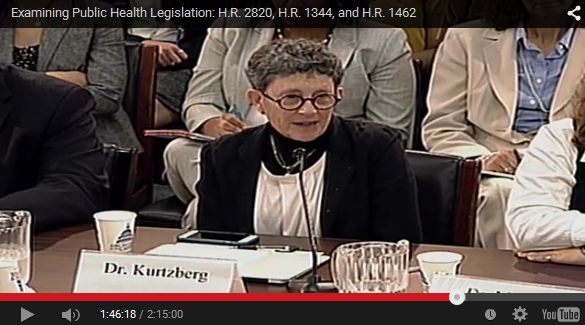Usted está aquí
2015 Reauthorization Stem Cell Therapeutic and Research Act

Since the passage of the Stem Cell Therapeutic and Research Act of 2005, the U.S. federal government has subsidized a national network of public cord blood banks. With this support, the U.S. inventory of unrelated donor cord blood units has increased to over 200,000. These are available to any patient in any nation who needs an unrelated donor for a transplant of blood-forming (hematopoietic) stem cells.
The legislation also supports the National Marrow Donor Program (NMDP), the Be The Match® registry of donors, coordinating centers for cord blood and adult donors, and an outcomes monitoring program at the Center for International Blood and Marrow Transplant Research (CIBMTR).
This legislation is up for "reauthorization" again this year.
Last month, Congressional Representatives Chris Smith and Doris Matsui, along with David Jolly and Chaka Fattah, introduced the Stem Cell Therapeutic and Research Reauthorization Act of 2015. The reauthorization bill provides five additional years of funding for the US national network of cord blood banks and for the associated registry, patient aide programs, and outcomes monitoring.
As President of the Cord Blood Association (CBA), one of my top priorities is to educate policymakers about cord blood research and transplantation and to advocate for passage of this important legislation.
Cord blood transplantation is used in adult and pediatric patients with leukemia and other blood cancers, bone marrow failure, inherited immunodeficiency syndromes, hemoglobinopathies like sickle cell anemia and thalassemia, and some inherited metabolic diseases. The latest research shows that cord blood transplantation also holds promise for treatment of patients with autism, traumatic brain injury, stroke and cerebral palsy.
CBA is an international non-profit organization that promotes public and private cord blood banking and the use of umbilical cord blood and related tissues for disease treatment and regenerative therapies. Our members include public and private cord blood banks, as well as health care providers in the cord blood community and their patients. Members are dedicated to promoting the work of the cord blood community, saving human lives, changing medicine and improving domestic and international policy.
Both CBA and NMDP are urging the U.S. Congress to pass the Stem Cell Therapeutic and Research Reauthorization Act of 2015. The original bill was spearheaded by Senator Orrin Hatch and former Senator Christopher Dodd along with Representatives Smith, Matsui and the late Bill Young. The 2005 law created the National Cord Blood Inventory (NCBI) program and the C.W. Bill Young Cell Transplantation Program and was reauthorized by Congress for five additional years in 2010. Since that five year period will conclude on September 30, 2015, these programs need to be reauthorized, once again, by Congress this year.
Lobbying for Reauthorization
On behalf of CBA, I recently met with key congressional leaders in the House and the Senate to urge support for the reauthorization legislation. During these meetings, I discussed the tremendous progress made in the field of cord blood transplantation as well as the challenges facing public cord blood banks from onerous federal licensure and contracting requirements. As a result of these meetings, several House Members cosponsored H.R. 2820. I expect similar levels of support when the Senate companion bill is introduced within the next few months, with sponsorship by Senators Orrin Hatch of Utah, Jack Reed of Rhode Island, Richard Burr of North Carolina and Al Franken of Minnesota.
The day after my Capitol Hill visits, the Energy and Commerce Health Subcommittee held a hearing on H.R. 2820. This subcommittee has jurisdiction over cord blood regulation, biomedical research, the Food and Drug Administration (FDA), and the Health Resources and Services Administration (HRSA). Witnesses in support of the bill included Dr. Jeff Chell, CEO of NMDP, and me on behalf of the CBA. In addition to challenges, we discussed how to encourage more expectant mothers to donate their cord blood, methods for cord blood collection and storage, the definition of a high-quality cord blood unit, cord blood therapies currently available to patients, and research underway to develop future treatments for other diseases.
Also of note, CBA and NMDP were successful in having a provision added to the annual federal funding bill in the House that would require the FDA to create a public/private working group to make recommendations for updated regulation of public cord blood banks.
Finally, along with representatives from the five public cord blood banks that hold FDA licenses and the NMDP, I participated in a recent meeting with officials from FDA and HRSA to discuss our collective experiences and practical concerns about banking and transplantation. Encouragingly, the meeting resulted in FDA officials offering to work with us on possible solutions.
Call to Action
| While CBA has had a successful few weeks in Washington, more work needs to be done. How can you help? | |
| First, ask your U.S. Representative to cosponsor H.R. 2820 and tell him or her that the bill needs to be passed this year. Currently, the legislation has a total of eight cosponsors. | |
| Second, ask your U.S. Representative to join the Congressional Caucus to Cure Blood Cancers and Other Blood Disorders. This Caucus educates House members and their staff about bone marrow and cord blood transplants and helps to promote our efforts. | |
| Third, call or write your U.S. Senator to express your support for their efforts to reauthorize the legislation. |


